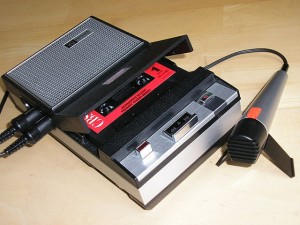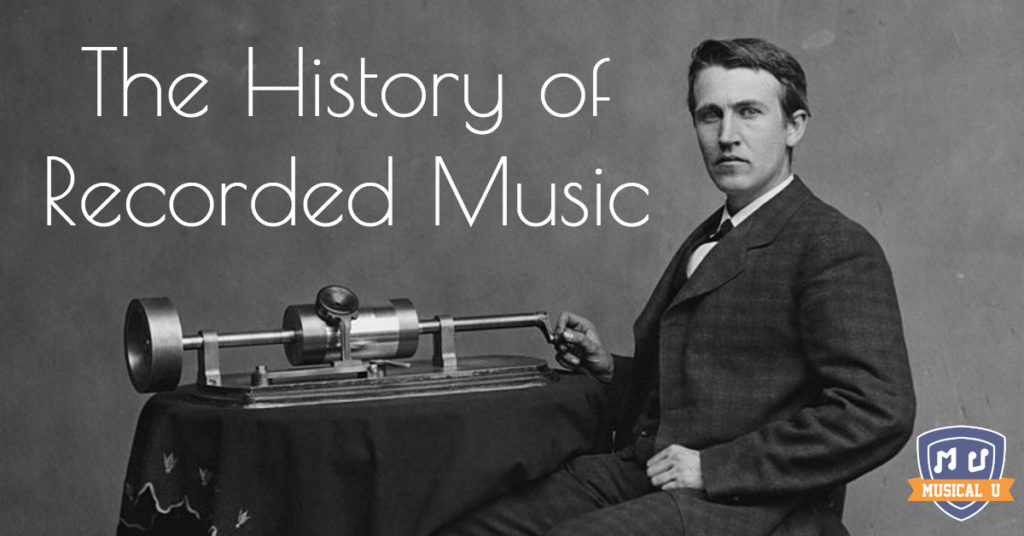These days recorded music is everywhere. Streaming over our phones, our computers, our MP3 players, Pandora, Soundcloud, YouTube, satellite radio – it seems to be coming out of the very air we breathe. There are even “retro” forms in revival, like vinyl and cassettes.
It’s hard to imagine the days when, if you wanted to hear music, you had to make it yourself or know somebody else who did. From then there were several steps – and some interesting detours – to the recording and distribution technology we have today.
My wife and I are avid vinyl collectors. We are the proud owners of an old Victrola, passed down in the family from my great grandmother. Most of you know about these old record players, but let’s have a peek at what came before.
The Early Days
Back in 1877, Thomas Edison used two needles on tinfoil cylinders. One needle was for recording and the other for playback. This was the creation of the phonograph. The first words he recorded were “Mary had a little lamb”:
In 1887 Edison built on improvements made by the Alexander Graham Bell lab invention, the Graphophone. Among other advancements, the tinfoil-covered cylinders were replaced by wax cylinders.
Many uses for recorded sound were envisioned, including talking dolls, business dictation, language preservation and keeping family history. But before long, recording and sharing music took on the lion’s share of the sound recording market.
The Edison Entertainment Company’s wax cylinder players, along with those of many competitors, endured into the 1920’s:
From Cylinder to Disc
In the 1890’s, inventor Emile Berliner unveiled the Gramophone. This was the first to stop recording on cylinders and start recording on flat disks. His first recorded words were “Twinkle, Twinkle Little Star”:
Berliner also invented a method of mass producing copies of the original record. Until Edison made improvements in his machines, Berliner’s Gramophone was the loudest machine on the market.
As you can see these early forms didn’t have much recording time. That was going to change.
An Industry is Born
In 1902 Edison introduced “Gold Moulded” cylinders for $.50 each with an improved hard wax surface. They were mass-produced by a molding process that actually emitted a gold vapor. Europe “Red Seal” 10-inch discs with 4-minute capacity were sold for $1.00, each featuring famous European artists. The first Red Seal records were recorded by the Russian Imperial Opera singer Feodor Chaliapin, who recorded 10 records for the Gramophone Co.
The Victor company began to import these celebrity labels in 1903 and became the leading seller of classical music records. The 10-inch disc quickly became more popular that the previous 7-inch standard disc that could only play for two or three minutes.
The Victrola
In 1906, the Victor Talking Machine Company debuted the Victrola. This line of “talking machines” tucked the turntable and amplifying horn away inside a wooden cabinet. Rather than increasing the audio fidelity, the idea was to produce a home phonograph that looked less like machinery and more like furniture. These internal horn machines were an immediate hit. Soon the brand name “Victrola” became synonymous with record player.
A range of styles and price ranges would follow – anything from a small tabletop for $15 all the way to a high-end gold trip designed for mansions at $600. Victrolas became by far the most popular type of home phonograph and sold in great numbers until the end of the 1920s.
Here is a really nice video of one of the Victrolas. The one my wife and I own is very similar to this one, just not as ornate:
Electronic Recording
In the 1920s inventors introduced electronic recording with microphones and amplifiers, and record players were gradually electrified as well. This was a vast improvement over the old mechanical methods. At first, only affordable to the most wealthy aficionados – an electronic record player cost as much as a new car – electronic technology began to infiltrate the market.
Tape Recording
Several visionary inventors had been working on electronic recording when the first reel-to-reel tape recorder and player, the Magnetophone, entered the arena in the mid-1930s. The first classical recordings were disappointing, however improvements in the tape helped.
In the early 1940s German engineers accidentally discovered high-bias recording when a “faulty” machine was brought in for repair. Suddenly, tape recording far surpassed the existing gramophone recording technology. The new machines were kept a closely guarded Nazi secret for the duration of World War II. Once the machines were discovered after the war, engineers quickly imitated and improved on them, and magnetic tape recording became the industry standard.
Wire Recording
On the other side of the Atlantic, the wire recorder and player was designed by Marvin Camras at Armour Research Foundation. It sold to the military during World War II. Wire recorders were popular with amateurs through the 1950s:
The Age of Vinyl
After many fascinating experiments with materials, the first vinyl records were produced in the 1930s, and soon demonstrated their superiority. Yet many of the old 78 rpm records were still made of various combinations of shellac into the 1950s.
In 1948 Columbia introduced the first 12-inch 33-1/3 rpm micro-groove LP vinylite record. The following year RCA Victor introduced 7-inch 45 rpm micro-groove “Extended Play” vinylite record and player. Eventually, the 33-1/3 and 45 rpm records were the only ones produced.
Vinyl records remained the primary medium throughout the 1950s, 60s, 70s, and into the 80s. They were not supplanted by the compact disc until 1988.
Cassettes
 In 1962 the Philips Company of the Netherlands invented and released the first compact audio cassette using high-quality polyester 1/8-inch tape produced by BASF. In 1964
In 1962 the Philips Company of the Netherlands invented and released the first compact audio cassette using high-quality polyester 1/8-inch tape produced by BASF. In 1964
The Norelco Carry-Corder dictation machine came out. While the means of recording records was bulky and expensive, cassette tapes became the first truly accessible, inexpensive personal recording medium.
Road Music
The first car radio appeared in 1930, developed by a team which included William Lear, later of Learjet fame. In their search to provide drivers with more control over their mobile music, manufacturers even tried to put record players in cars. Highway Hi-Fi was a system of players and seven-inch records for use in automobiles. The players were prone to malfunction. And the standard 7″ records had their grooves worn down rapidly by the high stylus pressure used to prevent skipping.
William Lear returned to the scene in the 1960s with the development of the 8-track stereo cartridge tape players developed. 8-track players were extremely popular until manufactured cassettes took over in the late 70s and early 80s.
Here is a vintage Mustang commercial where the 8-track was a featured accessory to the car:
Optical to Digital
Inventors first patented optical recording media in the mid-1960s, leading to the emergence of the Compact Disc in the early 80s. Compact discs, originally designed to replace the vinyl record as a music recording medium, soon found many other applications in the computer world. Even though revenues from digital media services have matched and surpassed physical recording media, worldwide the CD remains a hugely popular medium to this day.
Since the first pioneering efforts by the visionaries of the 19th century, inventors, engineers, and companies have worked incessantly to improve the quality and availability of recorded sound, seeking to satisfy an insatiable hunger for more access to more music in more places more of the time. The tradition continues today with one new digital audio service after another. It’s hard to imagine what’s beyond today’s nearly universal musical access – maybe you will be among the visionaries to reveal the next step in sound recording.







